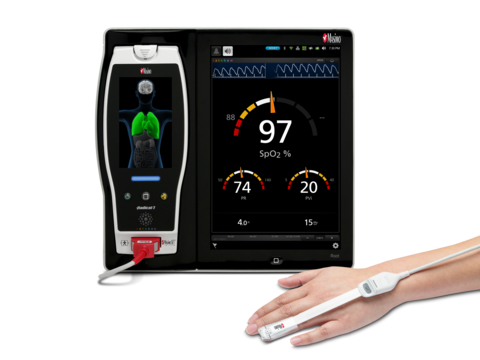IRVINE, Calif.– Masimo (NASDAQ: MASI) announced today the conclusions of a whitepaper published by the Society for the Advancement of Patient Blood Management (SABM) which highlights the importance of continuous hemoglobin (Hgb) monitoring to improve patient outcomes in critical care and perioperative settings.1 The authors of the publication concluded that “continuous Hgb monitoring devices provide highly valuable real-time trending data that can assist clinicians in making timelier decisions.”
Founded in 2001, SABM is recognized as a key educational resource for Patient Blood Management (PBM). The society defines PBM as the timely application of evidence-based medical and surgical concepts designed to maintain Hgb concentration, optimize hemostasis and minimize blood loss in an effort to improve patient outcomes. To that end, the SABM whitepaper reviews over 10 years of peer-reviewed publications on continuous hemoglobin in making its conclusion. The whitepaper notes that “having continuous access to Hgb levels in real-time offers a clear advantage over the traditional measurement methods as it enables the clinicians to detect changes in Hgb levels quickly and adjust the clinical management strategies accordingly.”
Masimo offers noninvasive and continuous hemoglobin monitoring, SpHb®, as part of its rainbow® Pulse CO-Oximetry platform. To display SpHb trends, Masimo rainbow® sensors can connect to a variety of Masimo Pulse CO-Oximeters®, including patient monitors available or in development from more than 20 other Masimo OEM Partners. For details, visit masimo.com/oem/partners. By utilizing multiple wavelengths of light, SpHb provides real-time visibility to changes, or lack of changes, in hemoglobin between invasive blood samples.
Continuous hemoglobin monitoring with SpHb as part of PBM programs has been found to improve outcomes in both high- and low- blood loss surgeries, such as reducing the percentage of patients receiving transfusions,2 reducing the units of red blood cells transfused per patient,3-4 reducing the time to transfusion,5 reducing costs,6 and even reducing mortality 30 and 90 days after surgery by 33% and 29%, respectively.7 This evidence of SpHb’s impact on outcomes spans the globe, representing 6 countries on 4 different continents.2-8
One of the key references cited by the whitepaper is the recent SABM Administrative and Clinical Standards for PBM Programs (5th edition). These standards recommend the “use of noninvasive hemoglobin and other laboratory measurements” as part of a strategy to reduce phlebotomy blood loss.9 Similarly, the latest pediatric standards from SABM (4th edition) recommend that “noninvasive techniques are used for monitoring of blood gases, hemoglobin and other analytes whenever possible.”10
Sherri Ozawa, RN, President of SABM, commented, “We believe that comprehensive patient blood management will be the global standard of care. The evidence shows that patient outcomes are better when a patient’s own blood is well managed and unnecessary transfusions are avoided. Clinicians need access to timely information that allows them to make better informed decisions, such as the information provided by noninvasive hemoglobin technology.”
The SABM whitepaper also discusses the role of pleth variability index (PVi®) as part of PBM. PVi is a continuous, noninvasive, dynamic indicator of fluid responsiveness in select populations of mechanically ventilated adult patients. It is a measure of the dynamic changes in perfusion index that occur during the respiratory cycle. The authors note that “combining such a measure with noninvasive Hgb monitoring can yield a more comprehensive picture of the hemodynamic and circulatory status of the patients.” More than 100 independent studies have demonstrated the utility of PVi as an indicator of fluid responsiveness.11
Dr. William Wilson, Chief Medical Officer of Masimo, stated, “Anesthesiologists and critical care physicians have long recognized the importance of dynamic measures of intravascular volume and fluid responsiveness. With the combination of PVi and SpHb, clinicians have a wealth of information at the bedside accessible through something as ubiquitous as a pulse oximetry sensor.”
Joe Kiani, Founder and CEO of Masimo, commented, “Since the launch of SpHb in 2008, we have seen over 75 countries adopt this technology and numerous publications noting its positive impact on outcomes. SABM is recognized as the premier provider of professional education in patient blood management. It’s great to see SABM recommend the use of SpHb and PVi to help improve patient outcomes.”
SpHb is not intended to replace laboratory blood testing. Clinical decisions regarding red blood cell transfusions should be based on the clinician’s judgment considering, among other factors, patient condition, continuous SpHb monitoring, and laboratory diagnostic tests using blood samples.
The accuracy of PVi in predicting fluid responsiveness is variable and influenced by numerous patient, procedure, and device-related factors. PVi measures the variation in the plethysmography amplitude but does not provide measurements of stroke volume or cardiac output. Fluid management decisions should be based on a complete assessment of the patient’s condition and should not be based solely on PVi.


